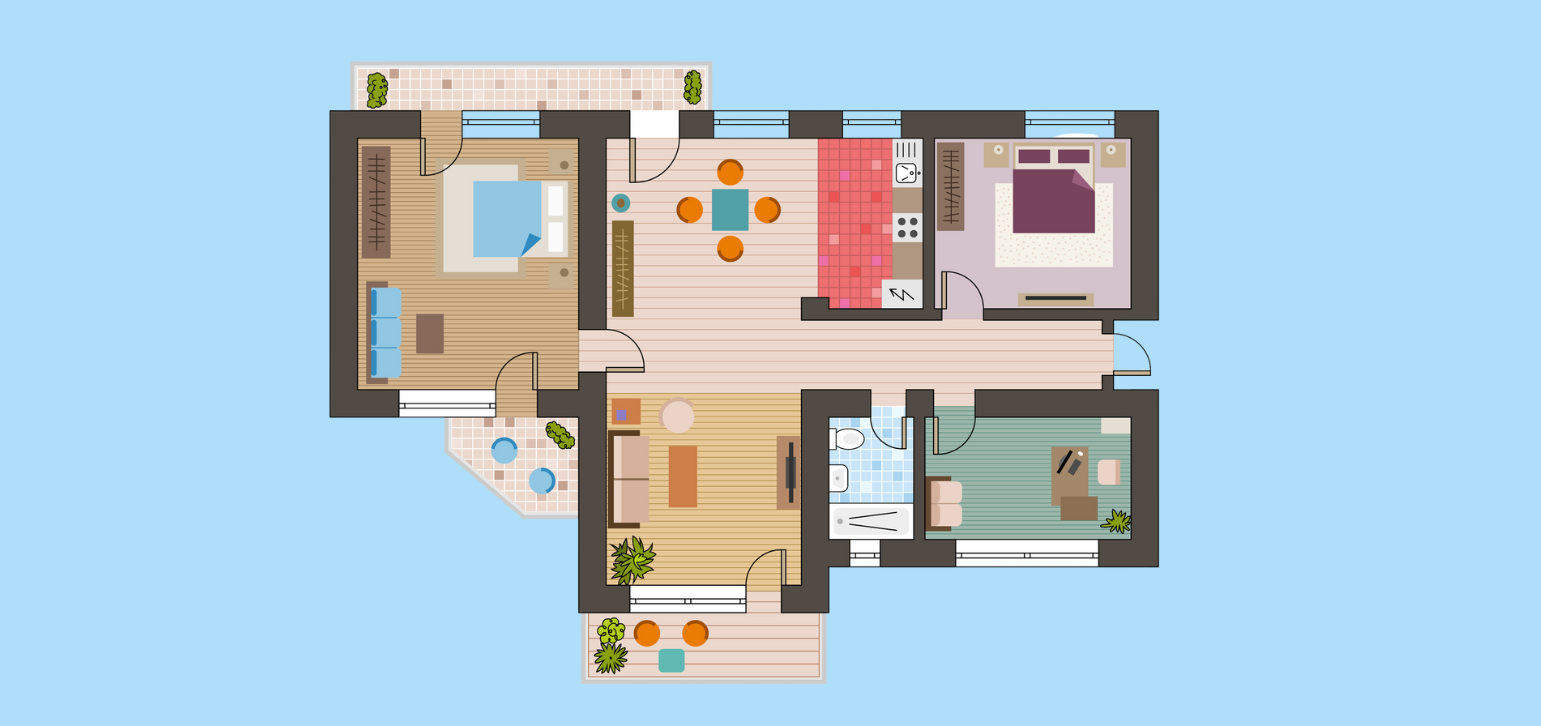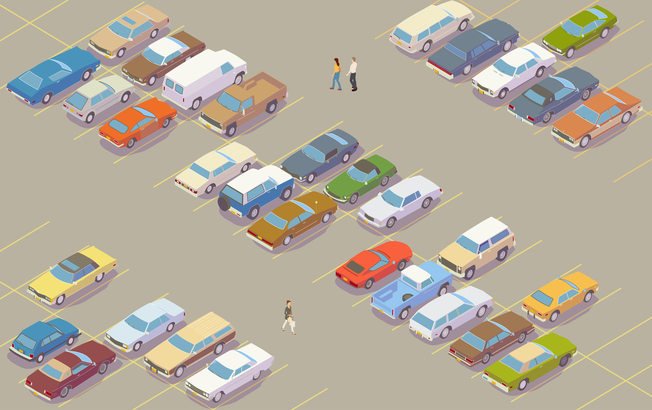
Every Kind of Apartment Layout, Explained

By Lilly Milman
Mar 05, 2024
Real estate terminology can be confusing. If you’re living alone, how do you figure out if you want a studio, efficiency apartment, or micro apartment? And why is the alcove studio more expensive than the rectangular studio?
When starting an apartment hunt, knowing the differences between apartment layouts is crucial. It can help you save time by allowing you to only submit inquiries on apartments with layouts you like — or potentially even find rent savings, if you know to look for layouts that tend to be more affordable.
Need help deciphering an apartment unit listing? Check out this guide of every type of apartment layout.
Guide to Different Types of Apartments
Convertible apartment: Essentially a studio with a small separate space, a convertible apartment is like an alcove studio with a partial wall and a sliding door put up to create separation for a bedroom. The separation could also look like a wall divider or it could be a hallway that separates two areas. Convertible studios can be a cheaper alternative to a true one-bedroom apartment.
Condominium: A condominium, also known as a condo, is a privately owned unit in a building filled with other privately owned units. Unlike a typical apartment building, which is usually owned by just one landlord or company and has many units that tend to look very similar, a condo building could have many unique units. Each unit will also likely come with its own rules and lease terms based on the owner’s preferences.
Duplex apartment: A duplex can refer to two distinct properties: A building containing two separate units in it or a single apartment that spans two floors. The latter is attractive for the extra space and separation it provides. For example, if a one-bedroom is a duplex, that may mean that the bedroom is a room upstairs while the kitchen and living area are downstairs.
Efficiency apartment: Some may use the terms studio apartment and efficiency apartment interchangeably, but an efficiency apartment will always have a kitchenette while a studio may have a kitchen. This comes down to the number of appliances, appliance size, and counter space. In an efficiency apartment, you will only find a mini fridge, a stovetop with only one or two burners, and minimal counter space. Both are small apartments.
Flex apartment: A flex apartment is one where a living space can be converted into another bedroom if necessary. For example, in a one-bedroom flex, the living room can be turned into a second bedroom if a curtain or wall divider is added (turning it into a two-bedroom apartment without a living room). A two-bedroom flex means there are two current bedrooms and a third bedroom can be created out of the living room, and so on.
Floor-through apartment: A floor-through apartment takes up an entire floor of a building, meaning you won’t have any neighbors. A floor-through apartment is often found in a building like a brownstone, townhouse, or rowhouse. If a floor-through apartment is in a larger apartment building or high-rise apartment building, it’ll usually be the penthouse on the top floor — and it will come with a steep price tag.
Garden-level apartment: While the term “garden-level” doesn’t refer to an apartment floor plan, it’s still important to know as you start your apartment hunt. A garden-level apartment is located slightly below street-level, in between a basement apartment and a ground-level apartment — meaning if you’re standing in a garden apartment, your head will probably be about even with the sidewalk. Like the name implies, they do often come with a “garden” or outdoor space. While they’re not ideal for everyone, they are often less pricey than apartments of similar size in similar neighborhoods.
In-law apartment: More popular in suburban areas, an in-law apartment is a unit with a separate entrance attached to a single-family home or are a separate structure on the same property, like a guest house. They will have their own kitchen and bathroom but are often smaller than a typical apartment. They are also called “mother-in-law suites,” “secondary suites,” or “accessory dwelling units” (ADUs).
Loft apartment: Found in former industrial buildings that have been converted into housing, a loft apartment is a space that retained its original characteristics: high ceilings, cement floors, open floor plans, and exposed pipes, beams, and brick walls. This is known as a “hard” loft. It may or may not have separation between the living space and the bedroom. A “soft” loft is made to look like it has these industrial characteristics, but it is newly built.
L-shaped or alcove studio: Unlike rectangular or square studios, L-shaped or alcove studio apartments give the illusion of separated rooms. The floor plan of these studios will either look like, well, an L shape or will have a small nook. Many renters choose to place their “bedroom” in the nook area.
Parlor-level apartment: The opposite of a garden-level apartment, a parlor-level apartment is slightly above street level or the ground floor. To get to a parlor-level apartment, you ascend a short flight of stairs. They are most common in older, prewar buildings like brownstones.
Micro apartment: Similar to a studio but much smaller, a micro apartment will be between 200 and 400 square feet total. This low amount of square footage is most ideal for someone who is not home often or does not need as much space for their belongings.
Railroad apartment: A railroad apartment is a unit where the layout of the rooms is like one long hallway. To get to one room, you must walk through another room — as if you are walking through train cars. So, for example, if there are two bedrooms at the back of the unit, then you’d need to walk through one to get to the other. Railroad apartments are often cheaper than other units of similar size or bedroom count because the layout can be less desirable for roommates.** **
Rowhouse or rowhome: Like a townhouse, a rowhouse is a multistory home that shares walls with adjacent properties. Rowhomes are narrow and tall, and usually are identical to multiple other homes, all in a row.
Studio apartment: A studio apartment is one single room, typically with a kitchen or kitchenette against one wall, and the only separate room being a bathroom. Studio apartments are typically on the smaller side — around 600 square feet or below — unless they are “oversized” studios. This means that the sleeping area will be in the same room as the living area.
Townhouse or townhome: Sometimes confused with a brownstone, a townhouse is a multistory home in a city. Usually, at least one of the walls is shared with an adjacent property. Often, a tenant rents the entire townhouse — though the floors may also be split up into separate apartments. If you are looking for a rental with enough space to have a separate dining room, living area, and multiple bedrooms, then a townhouse may be the best option for you.
Walk-up apartment: Also not exactly a floor plan, a walk-up apartment is a unit in a building without an elevator. Because it is less accessible and less convenient than an elevator building, a walk-up will usually be rented at a lower price point.
Top cities
Atlanta Apartments
1,999 apartments starting at $600/month
Austin Apartments
4,949 apartments starting at $600/month
Baltimore Apartments
1,472 apartments starting at $500/month
Boston Apartments
3,499 apartments starting at $940/month
Charlotte Apartments
2,903 apartments starting at $450/month
Chicago Apartments
4,012 apartments starting at $450/month
Dallas Apartments
5,609 apartments starting at $604/month
Fort Worth Apartments
2,193 apartments starting at $600/month
Houston Apartments
4,504 apartments starting at $590/month
Las Vegas Apartments
1,081 apartments starting at $704/month
Los Angeles Apartments
11,535 apartments starting at $625/month
Miami Apartments
544 apartments starting at $1,000/month
Milwaukee Apartments
928 apartments starting at $465/month
New York Apartments
4,118 apartments starting at $488/month
Oakland Apartments
608 apartments starting at $885/month
Orlando Apartments
842 apartments starting at $825/month
Philadelphia Apartments
3,657 apartments starting at $550/month
Phoenix Apartments
4,153 apartments starting at $599/month
Pittsburgh Apartments
1,223 apartments starting at $600/month
Portland Apartments
2,519 apartments starting at $599/month
Raleigh Apartments
1,367 apartments starting at $750/month
San Antonio Apartments
3,925 apartments starting at $525/month
San Diego Apartments
2,960 apartments starting at $650/month
San Francisco Apartments
436 apartments starting at $675/month
San Jose Apartments
405 apartments starting at $1,300/month
Seattle Apartments
3,623 apartments starting at $450/month
Tampa Apartments
1,078 apartments starting at $800/month
Washington DC Apartments
2,878 apartments starting at $745/month


